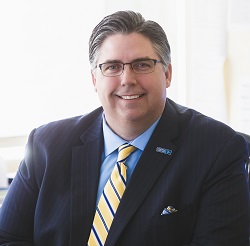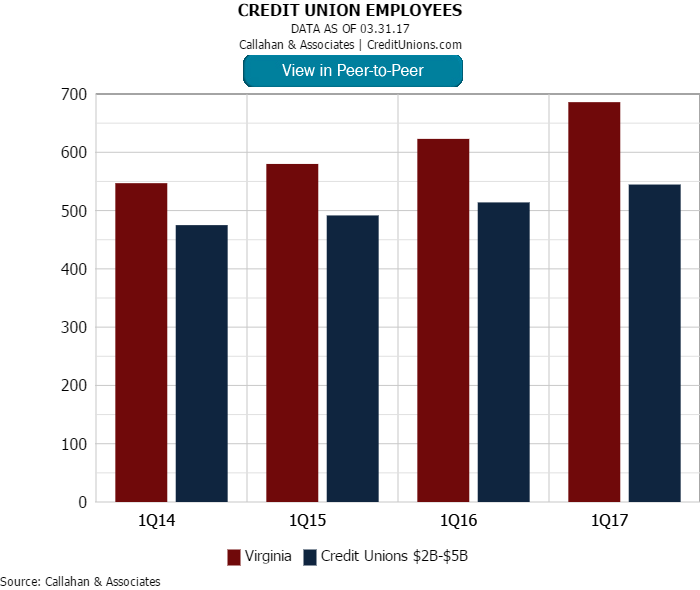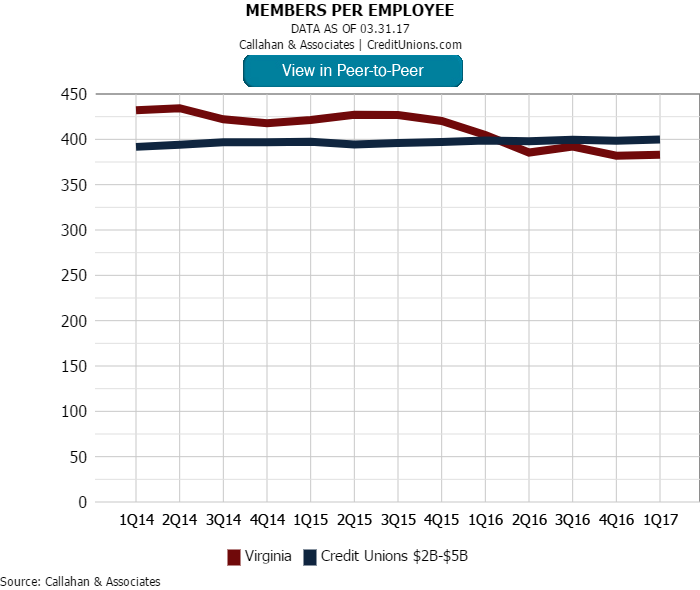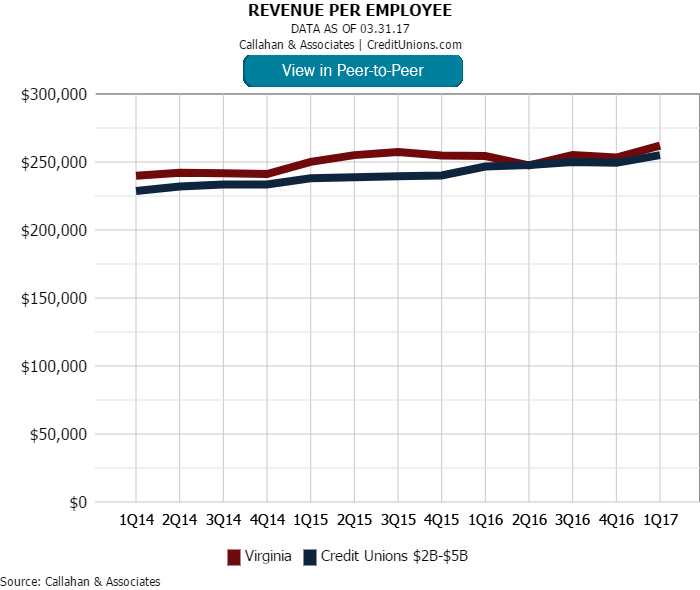CU QUICK FACTS
Virginia Credit Union
<span”>Data as of 03.31.17
HQ: Richmond, VA
ASSETS: $3.4B
MEMBERS: 258,188
BRANCHES: 17
12-MO SHARE GROWTH: 11.7%
12-MO LOAN GROWTH: 12.8%
ROA: 0.54%
Virginia Credit Union ($3.4B, Richmond, VA) has undertaken a hiring surge in which the Old Dominion credit union is seeking top talent to help lead the way forward into new areas of innovation.
Its search has unearthed such finds as a big bank data scientist and an innovation specialist from a major automaker who each joined the cooperative’s efforts to improve overall operations while creating new products and services that respond to changing consumer needs and expectations.
Here, Chris Shockley, a 12-year VACU employee who became president and CEO in March 2017, and Chris Saneda, executive vice president and chief information officer, discuss the credit union’s hiring spree and strategic initiatives.
How many hires has the credit union made lately. Why? And for what results?

Chris Saneda, EVP/CIO, Virginia Credit Union
Chris Saneda: Two elements in VACU’s 2015-2017 strategic plan are focused on building our mortgage portfolio and building digital engagement for our online channels. We’ve added 100 new budgeted positions in the past two years to support our overall operations, particularly these initiatives.
We’ve more than doubled our mortgage business in the past two years as we have shifted our focus from member refinances to purchases. In addition, 77% of our checking account holders actively participate in online banking and 35% are active with our mobile channel.
How do the concepts of data, process, and innovation fit into VACU’s overall operational strategy?
Saneda: Data, process, and innovation are foundational to effectively serving our membership. Data offers insight into what our members need. Process offers engaging approaches to interacting with our members and partners. Innovation offers the opportunity to experiment with opportunities in a low-risk way.
Chris Shockley: We have great confidence that the combination of these three disciplines ― data, process, and innovation ― will lead us down a path of creating engaging experiences for our members. For example, our staff has already worked in harmony to produce a pilot mortgage app that has reduced errors and taken four full days off the mortgage process.

Chris Shockley, President/CEO, Virginia Credit Union
Talk about the data scientist you hired from a big bank. What challenges and opportunities are you facing?
Shockley: Last year we created a team dedicated to better understand our members and their needs. In spring 2016, we hired an experienced leader, Pete Palermo, to be vice president of enterprise data analytics and direct our overall data management initiative.
Saneda: One of the members of Pete’s team is our data scientist, Richard Hayden, who stepped into this new role in January 2017. Richard is looking at our data to address specific business project needs ranging from a better understanding of operational capability to creating a smarter next-best-product model.
The data management effort includes such elements as data warehousing, governance, retention, reporting, analytics, modeling, and data science. Building the discipline takes time, particularly when we’ve asked the team to begin contributing right away even while this new approach is maturing.
We see tremendous potential in moving past general experimentation to leveraging model-based solutions built on internal and external data.
Back Your Decisions With Data
Callahan’s analytics software simplifies the process of benchmarking your performance data against that of other credit unions. This gives you more time to actually analyze the data and use it to make actionable decisions.

We’re also introducing some new process approaches. We’re using design theory and Lean Six Sigma with our current projects because they bring direct value to enhancing efficiency and removing barriers.
We’ve added 100 new budgeted positions in the past two years to support our overall operations and these particular initiatives.
How about the innovation specialist from a major automaker? How does her team’s work differ from traditional expectations?
Shockley: We hired Heather Meaker hired in March 2016 as our technology innovation manager. She leads an innovation team designed to bring new practices and tools to project execution. We know our traditional approaches will not keep us competitive in this hyper-changing world. This small team allows us to learn and change direction in rapid fashion with less risk.
Saneda: We created our innovation team specifically to focus on ideation, creation, and evaluation. We’ve asked them to focus on a small number of initiatives so they can quickly identify the right areas for investment. They’re guided by a cross-functional team with leaders from technology, products, and marketing.
Because the innovation team’s approach differs significantly from our traditional practices, they’re not subject to the rigor we customarily put forth. The intent is to try new ideas and assess what we can integrate into mainstream practices.
We’re looking to introduce leap-frog capabilities for our members that we might otherwise not consider. For example, the team has already given us understanding and insight that we’ve integrated with voice biometrics and artificial intelligence.
Click through the tabs below for a deeper dive intoVACU’s financial performance. Click on the graphs to view in Peer-to-Peer.
<$(‘.collapse’).collapse()
A GROWING WORKFORCE
VACU had 686 employees as of the first quarter of this year, compared with an average of 545 for credit unions with $2 billion to $5 million in assets, according to data from CallahanAssociates. Both have grown since March 31, 2014, when VACU had 547 and
VACU’S MEMBERS PER EMPLOYEE RATIO FALLS
VACU had 383 members per employee as of March 31, 2017. That’s down from 432 three years ago. The average for its asset-based peer group was 400 and 392, respectively, during those three years. The Virginia cooperative’s member growth rate was in line with the whole group’s.
ABOVE PEER REVENUE PER EMPLOYEE
VACU has been generating more revenue per employee than the average credit union of its size over the past 12 quarters. For the Richmond-based credit union, that metric jumped 10.8% from $239,852 to $262,050 in that time frame, whereas its asset-based peer group posted an 11.5% rise from $228,727 to $255,062.
A SPIKE IN SALARIES AND BENEFITS GROWTH
Hiring experienced people with specialized skills and backgrounds has helped VACU post some of the highest surges in salaries and benefits in its peer group. Its 17.19% year-over-year growth in the first quarter of 2017 puts it among the top 10 highest for credit unions with $2 billion to $5 billion in assets.
SPENDING MORE PER EMPLOYEE
VACU’s average spend per employee in first quarter 2017 was $93,718. That’s up 20.2% in the past three years from $77,937 as of March 31, 2014. The average for credit unions in its asset class rose 10.8% in the same period, jumping from $76,031 to $84,259.
How do you find employees like this?
Shockley: We use a variety of approaches. Our HR department relies on tools like LinkedIn, trusted staffing agencies, internal promotions, and employee referrals. Our good reputation in the marketplace, along with our employees who are advocates for us among job-seekers, has helped us with recruiting.




